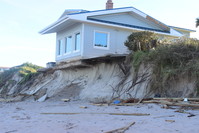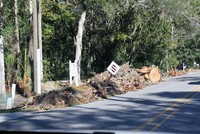


The Board of County Commissioners extended the local state of emergency during its Oct. 18 meeting, at which time commissioners approved pursuing efforts to relocate sand dredged from the St. Augustine inlet to protect endangered homes along State Road A1A.
In a report to county commissioners, County Administrator Michael Wanchick reviewed emergency management and storm recovery efforts before recommending that the local state of emergency be extended, which the board unanimously approved. Discussion then turned to the massive erosion experienced along the coastline that left numerous oceanfront homes in peril.
Wanchick presented a proposal to explore coordinating with the Army Corps of Engineers, Department of Environmental Protection and Florida Inland Navigation District (FIND) to redirect sand dredged from the St. Augustine inlet to the north beaches. That project, Wanchick said, was already approved and ready to begin construction in November, with the dredged material slated to be disposed of on Anastasia Island.
“Rather than send that stuff to an uninhabited island, we would send it to the north where we have this critical need,” Wanchick said. “That’s not a permanent long-term solution, but it’s the most viable solution we have available right now that could be quickly delivered in the next month to protect those homes until a more permanent solution is identified.”
Unlike other county renourishment projects, Wanchick noted, this project would differ in that the sand would be placed on private property, requiring the county to secure easements and permits from each individual homeowner. In addition, County Commissioner Bill McClure cautioned that doing so might negatively impact property owners’ home insurance policies.
“When you accept this (sand) because it’s been deemed a hazard area, that materially affects your insurance policy,” McClure said. “Be very aware, it effectively nullifies it. That’s an unintended consequence. Your personal property can be affected in that case.”
Wanchick acknowledged that there were a number of questions and issues to be addressed before the plan could be implemented, but said the plan was the only viable option currently available to address the threat to oceanfront properties.
“I guess falling into the ocean would also affect your insurance rates, too,” he observed.
During the public comment period, several residents raised the issue of building a seawall, which currently is deemed the responsibility of the individual homeowners. That presents a logistical problem if each homeowner attempts to construct his own wall, contended Robert Franskousky of the South Ponte Vedra-Vilano Beach Preservation Association.
“Can you imagine 19, 20 or 40 different contractors out on the beach trying to put in place all these different chains of walls that are all designed by different engineers?” he asked commissioners. “We absolutely have got to have government involvement or government design of a wall.”
Other residents, however, expressed concern about encouraging homeowners to rebuild their homes in an environmentally sensitive area.
“I’m worried about the taxpayers having to pick up the tab and subsidize these buildings in these areas,” Ellen Whitmer said. “This is really not wise because these storms…they come and when they come property is destroyed. I’m in sympathy to these people, but you don’t need to build on the beach.”
After public comment, commissioners unanimously approved pursuing the dredge relocation project.
Debris clean-up
Several county commissioners noted that the vast majority of calls they’re now receiving are from residents asking when storm debris will be collected. Wanchick said that the county is “focusing very intently” on debris collection, noting that more than 30,000 cubic yards of debris had already been collected. Given that Hurricane Matthew impacted Florida statewide, however, St. Johns County is in competition with other communities for FEMA-approved contractors, he said.
“It’s important to remember we have a county of 610 square miles,” said Wanchick, saying that he anticipated the county would have more than 20 crews in the field by this week.
“We understand that the only debris that really matters to most people is the debris in front of their own home," he said. "(The crews) are working as hard as they possibly can. We just ask people if they’ll be patient in that regard.”